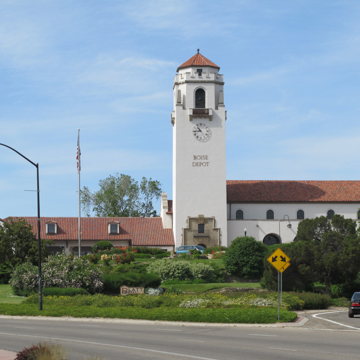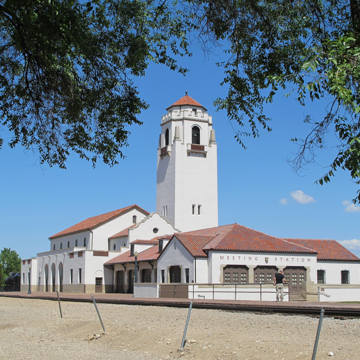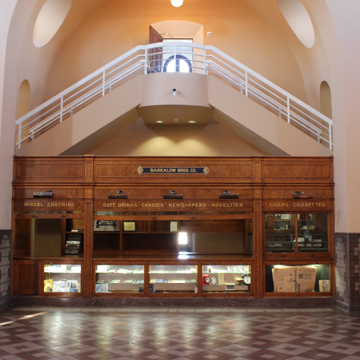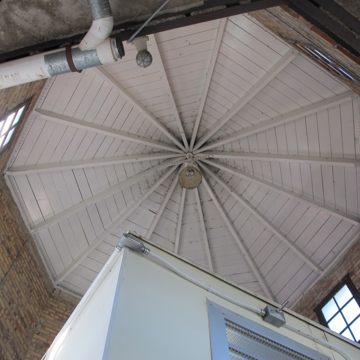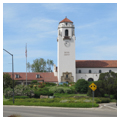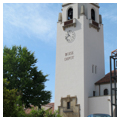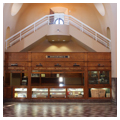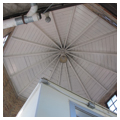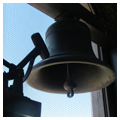You are here
Boise Depot
The Boise Depot, with its 96-foot-tall Spanish Colonial Revival tower is one of the city’s key landmarks. Located on the rim of the Boise River valley, and fronted by the beautiful Platt Gardens, the depot is a gateway to Idaho’s capital city. Along with the Idaho State Capitol, one mile away on Capitol Boulevard, the depot is also a tribute to Boise’s City Beautiful effort of the 1930s.
Boiseans had long sought to bring the railroad to town, but it was nearly twenty years after the 1869 completion of the transcontinental line that a spur of the Idaho Central finally reached the city. Boise’s valley location created a climb that railroad designers were anxious to avoid, and the city did not receive its own mainline until 1900. That year E. H. Harriman of the Union Pacific stipulated that citizens raise $250,000 to purchase the right of way but even after the funds were raised issues continued to impede development of the much-desired passenger line. By the mid-1920s the track was finally completed and in August of 1924 ground was broken for the new Union Pacific Depot.
Designed in 1924 by the New York firm Carrère and Hastings, Shreve and Lamb, the depot was highly regarded by locals. Charles Hummel, a long time Boise architect and civic leader called it “the most beautiful depot between Omaha and Portland.” The Spanish Colonial Revival (Mission) style depot has white stucco walls that contrast with orange terra-cotta tile roofs. Locally-quarried sandstone is used throughout the building, in walls, copings, obelisks, and boarders around doorways. The depot’s three principal elements, the large waiting room block, the lower office wing and the campanile, are arranged asymmetrically, with the tower dominating the composition. The large, two-story waiting room can hold up to 300 people. The roof structure of this great public space is composed of highly decorated wooden trusses. At the east end is a newsstand. Now carefully restored, it was operated for many years by the Barkalow Brothers, who were railway news agents along much of the Union Pacific.
The first train arrived at the recently completed depot on April 16, 1925, prompting celebrations, parades, and parties throughout the city to mark the end of Boise’s frustration as an “isolated capital.” Though the campanile may, as the Idaho Daily Statesman claimed, have been the “symbol of a dream come true,” the heyday of passenger rail was already receding.
Two years later, the Platt Gardens, named for the general manager of the Oregon Short Line, were planted below the depot. Spanish landscape architect Ricardo Espino designed the gardens with features still evident today, including waterfalls and koi ponds. Also in 1927, chimes were added to the campanile. Cast by Meneely Bell Company of New York and featuring a Seth Thomas Company clock and striking device, they were donated in honor of E. H. Harriman. They rang for the first time on Easter in 1927 and have chimed every quarter hour since then. Today, only the west chimes still ring, noise complaints having silenced the others.
During the early days of the Boise Depot, to the frustration of many locals, there was no direct access between the station and the city’s downtown area across the Boise River. In 1931, the completion of the Capitol Boulevard Memorial Bridge, constructed by Morrison Knudsen Corporation as a memorial to the pioneers of the Old Oregon Trail, solved this problem. It also completed the grand boulevard that Carrère and Hastings had proposed in their original plans.
For years the depot thrived, but its usage gradually declined. By 1948, there were six passenger trains coming through Boise each day, three from the west and three from the east. With fewer passengers, the Barkalow Brothers closed their newsstand in 1962. The U.S. Post Office discontinued mail freight in 1968 and in 1971 the last Portland Rose passenger train pulled out of the depot. Though Amtrak commenced passenger service through Boise in 1977, running trains between Seattle and Salt Lake City, this was discontinued in 1997.
By 1990, the depot was sixty-five years old and in need of repair. Morrison Knudsen Corporation purchased the depot from the Union Pacific Railroad and spent $3.4 million on a careful restoration. With the demise of Morrison Knudsen in the mid-1990s, the landmark depot was again in peril and without a responsible owner. In 1996, the City of Boise, under the leadership of Mayor Brent Coles, took possession of the building. Today the Boise Depot is open to the public two days a week and the great room is available for special events. It remains one of the most beloved sites in the Treasure Valley.
References
Attebery, Jennifer. Building Idaho, An Architectural History.Moscow, ID: University of Idaho Press, 1991.
Bauer, Barbara. “The Main Line Comes to Boise.” Idaho Yesterdays, The Journal of the Idaho State Historical Society44, no. 1 (2000).
Boudreaux, Crandal. “Boise Depot - Still Waiting on a Train.” Boise the Great. Accessed December 1, 2014. http://www.boisethegreat.com/articles/boisedepot.php.
Hart, Arthur A. Historic Boise, An Introduction to the Architecture of Boise, Idaho, 1863–1938. Boise, ID: Historic Idaho, Inc., 1993.
Hummel, Charles, and Tim Woodward. Quintessential Boise, an architectural journey. Boise, ID: Boise State University, 2010.
Idaho Chapter of the American Institute of Architects. “Capitol Boulevard Plan and Action Program.” City of Boise, September 1989. Accessed June 17, 2016.http://pds.cityofboise.org/media/242749/capitol_blvd_plan_action_program.pdf.
Jensen, Erica and Judith Austin, ed. Shaping Boise, A Selection of Boise’s Landmark Buildings.Boise, ID: City of Boise, Department of Planning and Development Services, 2010.
Klose, Olivia. “500 Fifth Avenue Designation Report.” New York City Landmarks Preservation Commission, December 14, 2010. Accessed June 16, 2016. http://www.nyc.gov/html/lpc/downloads/pdf/reports/2427.pdf.
Neil, J. Meredith. Saints and Oddfellows, A Bicentennial Sampler of Idaho Architecture. Boise, ID: Boise Gallery of Art Association, 1976.
Renk, Nancy, “Union Pacific Mainline Depot,” Ada County, Idaho. National Register of Historic Places Inventory-Nomination Form, 1974. National Park Service, U.S. Department of the Interior, Washington, DC.
“The Boise Depot, Then & Now.” Boise Parks and Recreation. Accessed December 1, 2014. https://parks.cityofboise.org/media/592398/15-0818-thenandnow-bd-v3_02.pdf.
Webb, Anna. 150 Boise Icons, to celebrate the city’s sesquicentennial. Boise, ID: Idaho Statesman, 2013.
Writing Credits
If SAH Archipedia has been useful to you, please consider supporting it.
SAH Archipedia tells the story of the United States through its buildings, landscapes, and cities. This freely available resource empowers the public with authoritative knowledge that deepens their understanding and appreciation of the built environment. But the Society of Architectural Historians, which created SAH Archipedia with University of Virginia Press, needs your support to maintain the high-caliber research, writing, photography, cartography, editing, design, and programming that make SAH Archipedia a trusted online resource available to all who value the history of place, heritage tourism, and learning.














